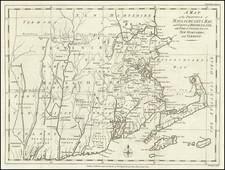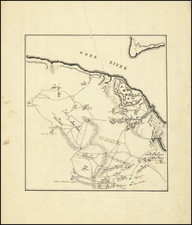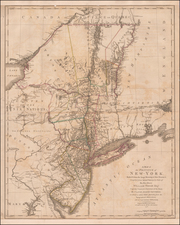"The Cornerstone of any American collection" - Clarence S. Brigham
"Few prints have influenced history as much as Paul Revere's engraving of the Boston Massacre of 1770." -
Paul Revere's sensational engraving of the Boston Massacre, surely the most prized print relating to the American Revolution, and a supreme example of the power of an image - whose symbolic weight transcended its obvious inaccuracies - in the creation of the memory of a key event in American history.
On March 5, 1770, British soldiers under the command of Captain Thomas Preston fired on an unruly crowd of dock and day laborers assembled in King Street near Boston harbor. The background of the fracas should be understood through the atmosphere of high tension prevailing in Boston due to the presence of as many as 4,000 British troops, some of whom were forcibly quartered in private homes. While the actual progression of events culminating in the massacre itself has been debated by historians for centuries, most agree that the melee started when a group of assorted dock people heckled a lone British soldier standing guard near the custom house. As a small contingent of soldiers arrived to relieve the initial guard, a larger mob of spectators joined the fray, including some young men who hurled snowballs and rocks at the soldiers. At some point, a wooden club struck a soldier. Shots were fired into the assembled crowd. In the resulting aftermath, five men lay dead or dying, including Crispus Attucks, an African American man of mixed Native American descent, and purportedly one of the ringleaders of the throng of rebellious colonists. Attucks has since been enshrined as a patriot and martyr to the cause of American freedom. Ironically, though named in the text below the image, he is depicted as a white man in Revere's etching.
While rife with inaccuracies, no one can doubt how this iconic print brings together several important threads of American history in a crucible of text and image that continues to resonate to this day. Chief among these themes is the love of freedom over tyranny. As a piece of propaganda in support of the colonial struggle against British tyranny, Revere's Bloody Massacre is without peer. First, the British soldiers are unequivocally depicted as the aggressors in the action. The officer in charge, Captain Preston, is shown wielding his sword high in the air as if giving the order to fire. The facial expressions of the red-coated soldiers, especially that of the soldier on the left, seem to reflect a sadistic pleasure at the violence being inflicted. Among those comprising the hapless crowd are figures begging for mercy, including a beshawled woman with hands clasped as if in prayer. Then there is the apocryphal Butcher's Hall, next to the very real Custom House. An often overlooked detail in the second-floor window of the provocatively named Butcher's Hall is the smoking barrel of a sniper's musket aimed directly at the colonists. During the court proceedings against the British soldiers several eyewitnesses claimed to have seen shots fired from the Custom House, suggesting a conspiracy involving a custom house official named Edward Manwaring, an outsider in Boston who might have felt a common cause with the soldiers. In defending the soldiers, Josiah Quincy II, John Adams' co-counsel in the trials of Captain Thomas Preston and the other soldiers, made a direct reference to the effects of the prints depicting the massacre then widely displayed in Boston homes and public places such as taverns:
The prints exhibited in our houses have added wings to fancy, and in the fervor of our zeal, reason is in hazard of being lost - Josiah Quincy, Jr.
As a premeditated hit against the court's limited chance of justice in the soldiers' case, Revere included eight lines of verse below the engraving. With references to the guiltless victims and the bribing of judges, followed by the names of the dead and wounded men themselves, these lines must have packed a powerful punch for Bostonians. In fact, the lines were cited in the court case against the British soldiers:
Unhappy Boston! See thy Sons deplore,
Thy hallow'd Walks besmear'd with guiltless Gore.
The Patriot's copious Tears for each are shed.
A glorious Tribute which embalms the Dead.
But know, Fate summons to that awful Goal.
Where justice strips the Murd'rer of his Soul:
Should venal C---rts the scandal of the Land.
Snatch the relentless Villain from her Hand.
Keen Execrations on this Plate inscrib'd.
Shall reach a Judge who never can be brib'd.
The unhappy Sufferers were Messrs. Saml. Gray, Saml. Maverick, Jams. Caldwell, Crispus Attucks & Patk. Carr, Killed
Six wounded; two of them (Christr. Monk & John Clark) Mortally
In addition to its status as a powerful piece of propaganda, Revere's opportunistic printing and marketing of such an item deserves attention. The image in Revere's print is a piracy from a drawing by the young artist Henry Pelham, John Copley's half-brother, who intended to put out his own print before any others. Revere, keenly aware of a financial opportunity, accessed Pelham's drawing, quickly adapted it into his own copper-plate etching, and ultimately beat Pelham to market with his own now-famous print. Revere advertised his print in the Boston Evening Post on March 26, 1770: "To be Sold by Edes and Gill (Price One Shilling Lawful) A Print, containing a Representation of the late horid Massacre in King-street." The speed of production of Revere's print can be perceived when comparing the notably crude lines of the Bloody Massacre with Revere's more carefully delineated commercial work commissioned by paying customers. Here is how Henry Pelham complained directly to Revere in a letter dated March 29, 1770:
Sir, when I heard that you was cutting a plate of the late Murder, I thought it impossible as I knew you was not capable of doing it unless you coppied it from mine and as I thought I had entrusted it in the hands of a person who had more regard to the dictates of Honour and Justice than to take the undue advantage you have done of the confidence and Trust I reposed in you. But I find I was mistaken and ofter being at the great Expence of making a design paying for paper, printing, &c find myself in the most ungenerous Manner deprived not only of any proposed Advantage but even of the expence I have been at, as truly as if you had plundered me on the highway.
When Pelham finally issued his own print, advertised for sale in the Boston Evening Post of April 2, 1770, he titled it The Fruits of Arbitrary Power, or the Bloody Massacre, but he was nearly a week too late, as Revere's version was already the dominant print in the market. A third version of the print, also based on Pelham's drawing, was later issued by Johnathan Mulliken, a Newburyport clockmaker. The image went on to be reproduced in a variety of print media in the following months: almost immediately Edes and Gill used Revere's plate to illustrate a broadside, then in 1771 Isaiah Thomas printed an almanac illustrated with a small woodcut based on the image. As late as 1775 Revere repurposed the image on Massachusetts Bay paper money.
While fewer copies of the Pelham and Mulliken prints are known to have survived, it is the Revere print that collectors have always desired:
"Paul Revere's Boston Massacre is the most famous and most desirable of all his engravings. It is the corner-stone of any American collection" - Clarence S. Brigham.
Like a modern crime scene photograph drawing the viewer in with a scene of horror on the one hand, but finally more like a religious icon in its power to inspire and instill belief in the righteousness of a cause, Paul Revere's Bloody Massacre transcended the boundaries of simple propaganda to join the pantheon of authentic American masterpieces.
Different states:
Offered here is a copy of the second state. An earlier state of the print, described by Brigham as having the clock on the steeple of the First Church reading 8 o’clock, is known in only two copies. The event actually occurred around 9 or 10 o'clock on a late winter night, and most copies, including this one, show the clock hands at 10:20.
Paper:
On laid paper watermarked with a crowned fleur-de-lis and LVG (the initials of the Dutch papermaker Lubertus van Gerrevink), which conforms to the watermarks seen by Brigham (and more recently by Fairbanks-Harris) on other copies of the Revere print.
The color:
The wide variation in the hand-coloring of extant copies is evidence that there was no single colorist, nor was there likely even a color "model" for the edition as a while. While the artist Christian Remick is sometimes proposed as the main colorist, that is more myth than reality. This is not to diminish the importance of the vivid color seen on most copies, especially the reds. Brigham clarifies how the emotional impact of the red coloring, as seen on the red coats and in the blood spewing forth from the dead and dying, is what really matters to the visual impact of the scene:
Christian Remick, mariner and artist, has for a century or more been credited with coloring Revere's print of the Boston Massacre. It is the crude, but effective, coloring - red for the British uniforms and the blood, blue, green, brown, and black - that gives charm to the print and makes it more desirable for the collector. Yet there is no documentary proof to show that Remick was the colorist, except that the copy in the Boston Museum of Fine Arts has in the lower right corner the inscription, in a contemporary hand, 'Cold by Christian Remick,' apparently written by Remick himself.
Edition and Extant copies:
Revere initially printed 200 copies. Brigham cites a March 28, 1770 entry in Revere's daybook for a charge of £5 by Edes & Gill for "Printing 200 Impressions of Massacre." Most historians believe that Revere had more copies printed shortly after, perhaps to meet the demand of the market. But as Eric Hinderaker has stated in his recent history of the Boston Massacre, it is not known how many additional print runs were made. Some suggest an overall total of several hundred, perhaps as many as 500 copies. The number of surviving copies (anywhere from 36 to 70) seems in line with an original production run of something under 500. For context on these numbers, the population of Boston at the time was approximately 15,000. Some writers, apparently surprised by the relatively high survival rate of Revere's print, have attributed this to the idea that he sold them framed. Others suggest that Paul Revere's name, a silversmith and engraver who was already a noted figure in Boston if not yet enshrined as a great patriot, and whose name appears prominently on the print, inspired Bostonians to preserve the item in higher numbers than the now rarer Henry Pelham or Jonathan Mulliken versions. Revere's print came out before the others, certainly an advantage. But the obvious reason for the good survival rate is the image itself: the emotive quality of the scene depicted, due mainly to its brilliant red coloring, all but ensured a wide circulation.









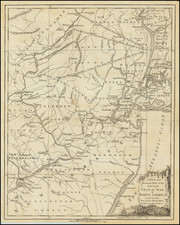
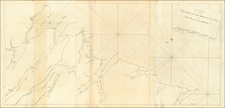
![( South Carolina Manuscript Plat Map ) [Land grant document signed by Revolutionary War hero William Moultrie with plat map signed by surveyor general Peter Bremar and deputy surveyor David Reynolds] State of South-Carolina. To all to whom these presents shall come, greeting... by these Presents do grant unto the said Harmon Dees ... a Plantation or Tract of Land, containing Four Hundred Acres situate in the District of Camden on Polly Bridge Swamp waters of Black River](https://storage.googleapis.com/raremaps/img/small/84439.jpg)
